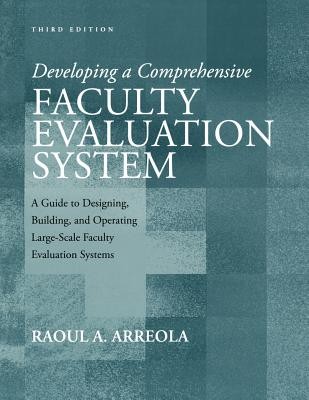
- We will send in 10–14 business days.
- Author: Raoul A Arreola
- Publisher: Jossey-Bass
- ISBN-10: 1933371110
- ISBN-13: 9781933371115
- Format: 21.9 x 27.8 x 1.5 cm, minkšti viršeliai
- Language: English
- SAVE -10% with code: EXTRA
Developing a Comprehensive Faculty Evaluation System (e-book) (used book) | bookbook.eu
Reviews
Description
This handbook provides a systematic, proven approach for developing a fair and consistent faculty evaluation system that can be adapted to the unique values, needs, missions, traditions, and overall culture of any institution. Based on thirty-six years of research and experience building and operating large-scale faculty evaluation systems and consulting to thousands of college and university personnel, the author has established an eight-step process for building a comprehensive evaluation system. These steps include
- Determining the faculty role model
- Determining the faculty role model parameter values
- Determining roles in the faculty role model
- Determining role component weights
- Determining appropriate sources of information
- Determining the source impact weights
- Determining how information should be gathered
- Completing the system by selecting or designing forms, protocols, and rating scales
In this third edition, each step, including the definitions of the various roles to be evaluated, has been expanded and enhanced based on the experiences of many institutions that have followed the procedure outlined in the book. The third edition also features a new introduction; fresh research in the field; updated forms and procedures; a new, detailed case study of an institution that developed a Web-enabled, computer-supported system based on the eight-step process; and a new body of work that defines the professoriate as a meta-profession with a rubric for defining more than twenty faculty skill sets.
Readers will learn how to generate and use an overall composite rating in promotion, tenure, merit pay, and post-tenure review decisions; they will also discover the issues in designing or finding, using and cataloging student rating forms. Sample forms, worksheets, models, and sample faculty evaluation manuals round out this practical, user-friendly handbook for anyone developing a faculty evaluation system.
EXTRA 10 % discount with code: EXTRA
The promotion ends in 23d.22:41:53
The discount code is valid when purchasing from 10 €. Discounts do not stack.
- Author: Raoul A Arreola
- Publisher: Jossey-Bass
- ISBN-10: 1933371110
- ISBN-13: 9781933371115
- Format: 21.9 x 27.8 x 1.5 cm, minkšti viršeliai
- Language: English English
This handbook provides a systematic, proven approach for developing a fair and consistent faculty evaluation system that can be adapted to the unique values, needs, missions, traditions, and overall culture of any institution. Based on thirty-six years of research and experience building and operating large-scale faculty evaluation systems and consulting to thousands of college and university personnel, the author has established an eight-step process for building a comprehensive evaluation system. These steps include
- Determining the faculty role model
- Determining the faculty role model parameter values
- Determining roles in the faculty role model
- Determining role component weights
- Determining appropriate sources of information
- Determining the source impact weights
- Determining how information should be gathered
- Completing the system by selecting or designing forms, protocols, and rating scales
In this third edition, each step, including the definitions of the various roles to be evaluated, has been expanded and enhanced based on the experiences of many institutions that have followed the procedure outlined in the book. The third edition also features a new introduction; fresh research in the field; updated forms and procedures; a new, detailed case study of an institution that developed a Web-enabled, computer-supported system based on the eight-step process; and a new body of work that defines the professoriate as a meta-profession with a rubric for defining more than twenty faculty skill sets.
Readers will learn how to generate and use an overall composite rating in promotion, tenure, merit pay, and post-tenure review decisions; they will also discover the issues in designing or finding, using and cataloging student rating forms. Sample forms, worksheets, models, and sample faculty evaluation manuals round out this practical, user-friendly handbook for anyone developing a faculty evaluation system.


Reviews